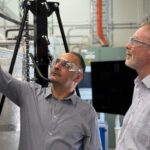Building work has begun on a landmark natural gas research facility which could significantly shape future offshore projects around the world.
Curtin University and Chevron Australia are partnering on a $4 million Extreme Service Flow Loop facility, which broke ground today at Technology Park, near the University’s Bentley campus.
Project Chief Investigator Dr Ammar Al Helal said natural gas is vital to transition to clean energy and the innovative research project aims to revolutionise how offshore facilities manage corrosion, which can be a costly and time-consuming challenge.
“The flow loop will be made from Hastelloy, a high nickel alloy able to withstand extreme corrosive conditions,” Dr Al Helal said.
“It will simulate various corrosive conditions found inside pipelines and other high-flow environments in the industry.
“This will allow operators to better measure and predict the effects of corrosion on a given project, which will not only reduce costs but also reduce the risk of damage to infrastructure and the environment.”
The Curtin and Chevron project will not only offer an Australian-based alternative to overseas testing but will also be the only flow loop in the world capable of mimicking corrosive conditions in the presence of mercury vapour, which in other facilities can result in escalated costs, lengthy time delays and limited control over testing.
Curtin Corrosion Centre Director and Emeritus Professor Brian Kinsella said the flow loop would also be an invaluable training opportunity, with several PhD research programs using it to obtain data for controlling corrosion.
“The projects will train students in the use of pressure vessels and flow equipment important for work in the petroleum industry,” Professor Kinsella said.
“The flow loop will be available to other companies for research and development purposes after the completion of the Chevron research program.
“This partnership is an excellent example of academia and industry working together for the mutual benefit of all.”
Phase one of the project is the construction of a building with special facilities which will house the flow loop, which will be installed once the building is completed.
“Today, we are witnessing the successful outcomes of the diligent efforts of the internal corrosion team, brilliantly led initially by the late Dr Ahmed Barifcani and supported by team members Dr Al Helal, Darwin Hartono, Dr Christopher Lagat, Francisco Javier Vouilloz and Fenny Kho,” Professor Kinsella said.
“The project is now emerging into the light, signifying a significant milestone in our pursuit of excellence in corrosion and flow assurance research and testing.”



